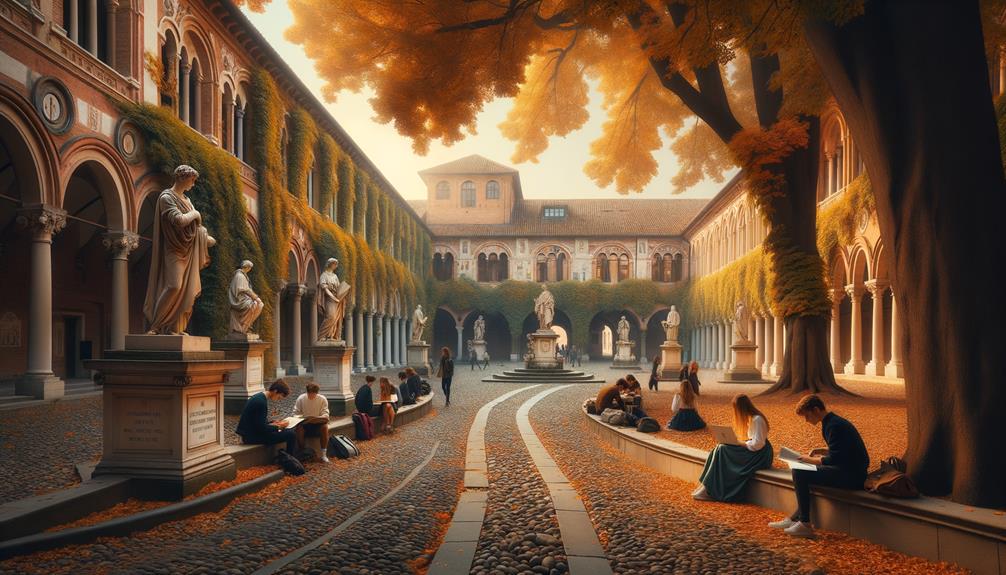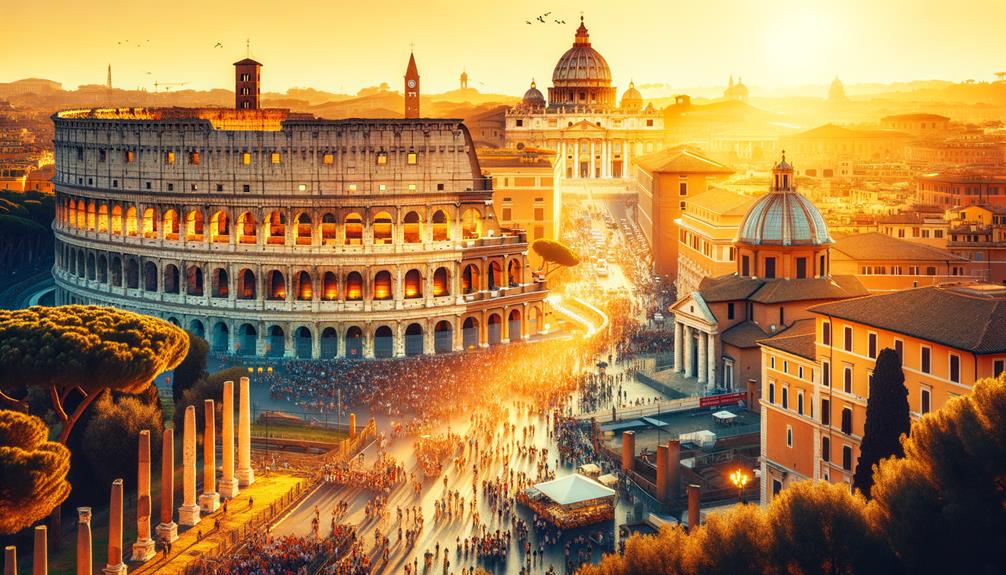Did you know that Pavia University, founded in 1361, is one of Italy's oldest schools? Walking through its old courtyards, with columned paths and stone benches, I felt surrounded by history. The university's museum showcases Volta's inventions and works by Nobel laureates, offering a glimpse into its rich past. As I ventured further into Pavia's historic center, landmarks like the Pavia Cathedral and Visconti Castle caught my eye, each a testament to the region's medieval splendor. There's so much more to learn about this enduring educational gem.
Foundation and Early Years
Founded in 1361 by Holy Roman Emperor Charles IV, Pavia University stands as one of Italy's oldest and most respected educational institutions. Walking through its ancient halls, you can almost feel the layers of history that have built up over centuries. The founding of the University of Pavia was a landmark moment in medieval Europe's intellectual life. Just imagine scholars from all over the continent coming to this city, eager to learn and share their knowledge.
In those early days, the university was a rare haven for free thinking and intellectual exploration. Both students and professors thrived in an atmosphere that encouraged the exchange of ideas, offering a much-needed respite from a world often dominated by conflict and rigid beliefs. The establishment of the University of Pavia represented a forward-thinking dedication to education.
Strolling along those cobblestone paths, I felt a connection to the first scholars who challenged the norms of their time. Their early years were defined by a deep love for learning and an unyielding search for truth—values that still echo within the university's walls today.
Architectural Marvels
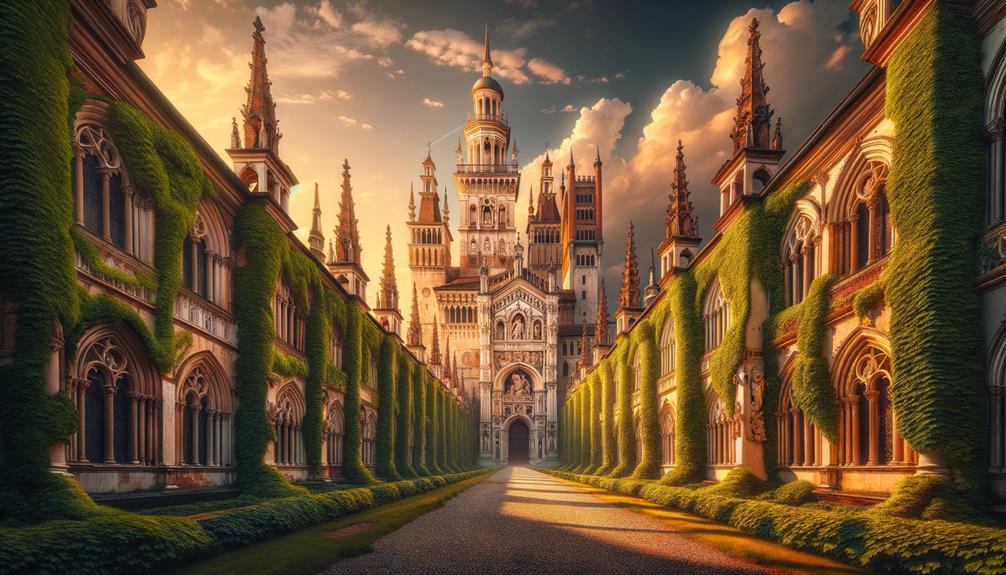
Strolling through the historic buildings of Pavia University, I was struck by the seamless blend of medieval and Renaissance design. The frescoes and stucco work in Aula Foscoliana and Aula Volta were truly impressive, showcasing intricate Baroque artistry. Walking through the cloistered courtyards, with their ancient arches and columns, felt like a trip back in time.
Medieval Structural Elements
Strolling through Pavia University, I'm struck by the beauty of the Gothic arches and the sturdy stone walls that highlight medieval architectural skill. Each step on the old cobblestones takes me back to an era when Pavia City was a bustling hub of learning and culture. Founded in 1361, Pavia's medieval structures offer a direct link to its rich history.
Inside, the dim hallways with narrow windows and heavy wooden doors evoke a deep sense of the past. The university's courtyards, with their columned walkways and stone benches, provide spots for reflection and rest. It's easy to picture scholars from centuries ago discussing philosophy under these very arches.
| Element | Emotion Evoked |
|---|---|
| Gothic Arches | Awe |
| Stone Walls | Resilience |
| Cloistered Columns | Contemplation |
Walking through these spaces, I feel connected to the generations of students and scholars who have walked these same paths, their hopes and dreams resonating through the stone corridors. Pavia University's medieval architecture isn't just a collection of buildings; it's a testament to human curiosity and the pursuit of knowledge.
Renaissance Design Influence
Entering the Pavia University History Museum, the Renaissance design strikes me immediately. The ornate facades, grand staircases, and beautifully decorated ceilings pull me into a time of cultural and artistic revival. As I stroll through the courtyard, surrounded by Renaissance-style structures, I feel a deep peace. It seems like the very stones beneath my feet are filled with stories of scholars and visionaries who once walked these paths.
Walking along Strada Nuova, I admire the perfect blend of historic and modern elements. Nearby, the Certosa Museum showcases frescoes and sculptures that highlight the artistic skill of the Renaissance era. Each piece offers a glimpse into a time of boundless creativity.
The Visconti Castle, with its grand halls and ornate windows, stands as a testament to Pavia's rich heritage. Equally impressive is the San Michele Maggiore church, whose majestic facade and detailed frescoes exemplify the blend of medieval and Renaissance styles that define the city's architectural wonders.
Baroque Artistic Details
The Baroque details in Pavia's architecture are truly fascinating, blending intricate designs with a rich history. As I wander through the Pavia Cathedral, the frescoes and mosaics catch my eye, each stroke and tile telling a tale of artistry and devotion.
When I visit the Visconti Castle, I'm drawn to the grand staircase and the beautiful courtyard, both added in the 17th and 18th centuries. These Baroque touches breathe new life into the medieval fortress, merging strength and beauty effortlessly.
At the Certosa Museum, within the UNESCO-listed Certosa di Pavia, the Baroque art and artifacts are overwhelming. This former Carthusian monastery, dating back to the 14th century, showcases treasures that reflect the era's opulence and spiritual intensity.
San Michele Maggiore, with its impressive façade and lavish frescoes from the 17th-century renovations, offers another look at Baroque brilliance. The church's transformation highlights the period's love for dramatic and expressive design.
Notable Alumni
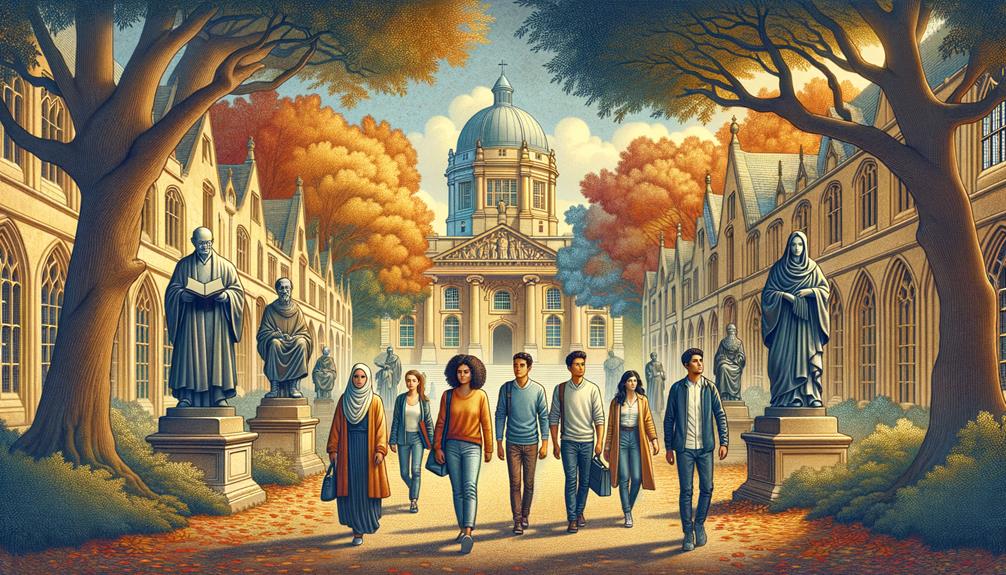
Walking through the historic halls of Pavia University, I can't help but feel its rich legacy. Renowned scientific minds like Alessandro Volta once roamed these corridors, and influential political figures who shaped Italy's history also walked these paths. Each corner of this venerable institution tells stories of those who have left a lasting impact on the world.
Renowned Scientific Minds
As I walk through the historic halls of Pavia University, I'm struck by the profound legacy of its alumni, whose scientific achievements have shaped our world. Strolling through these corridors, I can almost sense the presence of intellectual titans like Alessandro Volta and Camillo Golgi. Every nook of this storied institution seems to whisper tales of discovery and innovation.
Here's a glimpse into the lives of some of these remarkable minds:
| Name | Field of Study | Notable Achievements |
|---|---|---|
| Alessandro Volta | Physics | Invented the electric battery |
| Camillo Golgi | Medicine | Discovered the Golgi apparatus |
| Gerolamo Cardano | Mathematics | Developed foundational principles of probability |
Walking where these pioneers once walked, I am deeply moved by their tireless quest for knowledge and their freedom to explore new frontiers. Volta's invention of the electric battery transformed our understanding of electricity, while Golgi's research set the stage for modern cellular biology. Cardano's work in mathematics has had a lasting influence, shaping the field for generations to come.
As I delve deeper into their stories, it becomes clear that Pavia University is more than just an educational institution; it's a hub of innovation and a testament to the enduring spirit of inquiry and intellectual freedom.
Influential Political Figures
As I wander through the historic halls of Pavia University, I'm struck by the political heavyweights who once walked these corridors. Their legacies are woven into Italy's rich history, showcasing their bravery, intelligence, and leadership. Following in their footsteps, I feel a connection to their lasting impact on politics.
Some notable alumni include:
- Alessandro Volta: Famous for his scientific achievements, Volta also served as a senator in the Napoleonic Kingdom of Italy, proving his political prowess.
- Cesare Beccaria: Known worldwide for his groundbreaking work on criminal justice, Beccaria's ideas laid the foundation for modern legal systems.
- Giuseppe Mazzini: A passionate nationalist, Mazzini's tireless efforts for Italian unification inspired freedom movements across Europe.
- Carlo Cattaneo: A strong advocate for federalism, Cattaneo's writings and actions had a significant impact on Italian political thought.
Thinking about their stories, it's clear that Pavia is more than just a university; it's a place where ideas about freedom and justice have been shaped. These figures remind me that education can drive change for those who seek it.
Scientific Contributions
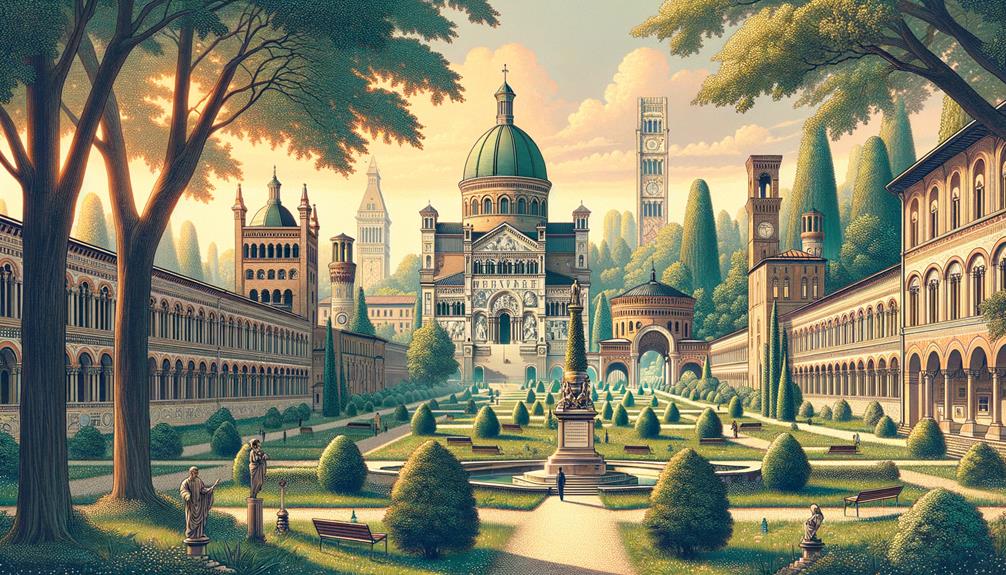
Pavia University has long been a hub of significant scientific research and innovation. Walking through its historic halls, you can almost sense the intellectual energy that has driven centuries of discovery. From groundbreaking medical advancements to pioneering physics theories, Pavia has made a lasting impact on the scientific community.
Consider these remarkable contributions made here:
| Scientist | Field | Major Contribution |
|---|---|---|
| Alessandro Volta | Physics | Invented the electric battery |
| Camillo Golgi | Medicine | Discovered the Golgi apparatus |
| Gerolamo Cardano | Mathematics | Developed a formula for solving cubics |
| Antonio Scarpa | Anatomy | Created detailed anatomical illustrations |
Volta's invention of the electric battery, for instance, was the spark for the electrical advancements that followed. Imagine the first electric currents running through his lab, just steps from where students walk today. Golgi's meticulous work laid the foundation for modern cell biology. Cardano's equations continue to challenge and inspire new generations of mathematicians.
Every corner of this university echoes with the stories of relentless curiosity and the freedom to pursue knowledge. It's a testament to the enduring human spirit and its drive to understand the world, celebrating both our history and our future.
Literary Heritage

Walking into the University of Pavia, you immediately sense its profound literary heritage. Dante's verses and Einstein's theories seem to mingle within its historic walls. This renowned institution has nurtured some of the most brilliant minds in history, each adding to its rich legacy of knowledge and culture.
As I wandered through the university's halls, I came across:
- Handwritten documents by Nobel laureates like Albert Einstein, preserved in the university museum.
- References to Dante Alighieri, whose Divine Comedy was partly influenced by his time in Pavia.
- The legacy of Alessandro Volta, the inventor of the electric battery, whose innovations continue to inspire.
- The work of Camillo Golgi, a Nobel Prize winner in Physiology or Medicine, whose contributions remain crucial to medical science.
Exploring Pavia itself, the city's literary importance becomes even clearer. The medieval streets and Renaissance buildings echo tales of past scholars. The University of Pavia is not just an educational institution; it's a vibrant museum of literary and scientific discovery. Here, history isn't trapped in old books but lives on in every lecture hall and library, inviting you to join its ongoing story.
Must-See Landmarks
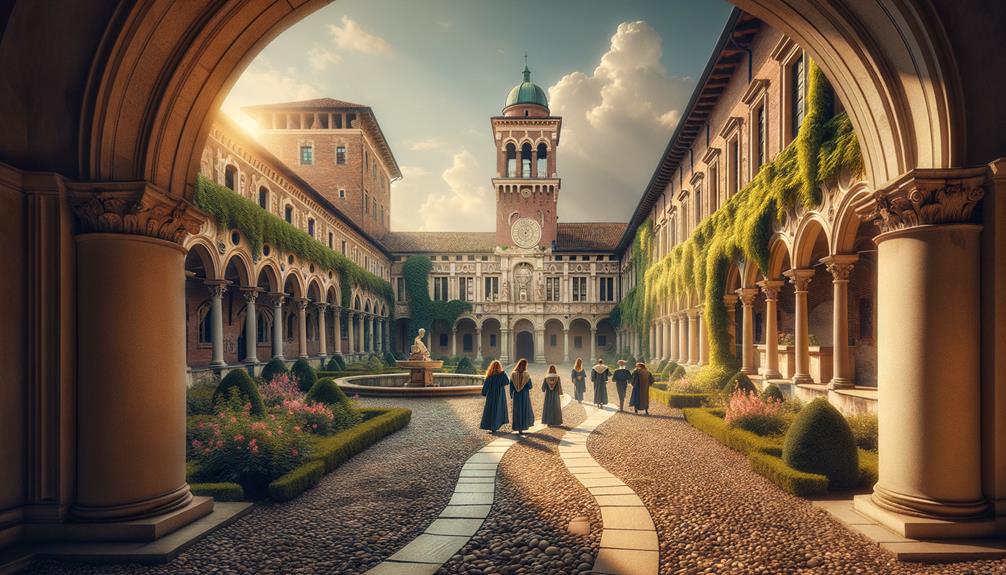
As I continued my exploration, the charm of the University of Pavia's landmarks drew me in with their deep historical roots and stunning architecture. The Pavia University History Museum, opened in 1936, stands as a testament to the university's importance. Inside, I was fascinated by Alessandro Volta's inventions and an intriguing collection of physics instruments. Handwritten documents from Nobel laureates like Camillo Golgi and Albert Einstein added a layer of intellectual awe to the experience.
The museum's outer corridors and courtyards, part of the university's historic buildings, offered glimpses into its medieval past. Walking through these spaces felt like a journey back in time.
To truly appreciate the university's cultural heritage, a guided tour is highly recommended. This tour not only covers the university's campus but also the historic center of Pavia, home to other remarkable landmarks.
| Landmark | Significance |
|---|---|
| Pavia University Museum | Showcases university history, Volta's inventions, and Nobel laureates' works |
| Pavia Cathedral | A stunning architectural gem with deep historical roots |
| Ponte Coperto | Iconic covered bridge with historical importance |
| Visconti Castle | Medieval castle with a rich historical context |
| San Michele Maggiore | A masterpiece of Romanesque architecture |
Each landmark tells a story, weaving a rich cultural fabric that's impossible to ignore.
Frequently Asked Questions
Is University of Pavia Prestigious?
Oh, definitely! The University of Pavia has an impressive reputation. When I was there, I was really struck by its deep history, academic quality, and beautiful buildings. Walking around, you can almost feel the presence of past Nobel Prize winners and other important figures. It's a really inspiring place.
Is Pavia Walkable?
Pavia is a fantastic place to walk around. I wandered through its charming streets, coming across cozy cafes and stunning architecture. Being able to explore at my own speed made the experience even more enjoyable, blending history and modern life perfectly.
What Is the History of the University of Pavia?
The University of Pavia has a rich history, dating back to 1361. As I walked through its historic corridors, I could almost hear the echoes of past scholars. The university beautifully blends its deep-rooted traditions with modern advancements.
What Is the Ranking of Pavia Medical School?
I was truly impressed by the University of Pavia's Faculty of Medicine and Surgery, which ranks among the top 300 in the world. It's well-known for its innovative research in areas like neuroscience, cardiovascular disease, and cancer. Students also benefit from exceptional clinical experiences thanks to its strong connections with various teaching hospitals.

